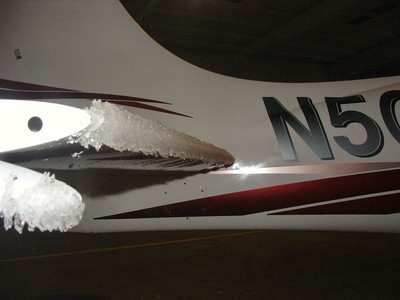Avoiding That "Chilling" Sensation
For those of us who have "hit the boots" (or the equivalent
system on your favorite bird) a few times in the last few days
(despite my home base in Northern Florida...) due to the
ever-present seasonal 'charms' of in-flight icing, we thought a
series of short tips from Cirrus Design's Scott Winter (yes, that
IS his real name) might help us all to consider some of the
realities of this time of year.

So... here are the first of seven tips for dealing with icing.
Y'all be careful out there!
Icing Aero-Tip #1
 With the changing of the seasons,
also comes the changing of the weather. For some in the northern
parts of the United States and Canada, snow has already covered the
ground, as well as airplanes!
With the changing of the seasons,
also comes the changing of the weather. For some in the northern
parts of the United States and Canada, snow has already covered the
ground, as well as airplanes!
While icing is not a new concept for pilots, just as one needs
to spend time reviewing those winter driving skills, so must pilots
review winter flying skills that could be life saving! General
aviation flying can be accomplished safely and effectively in the
winter months as long as pilots follow a few simple rules to keep
them safe.
During the pre-flight planning, look up pertinent information
regarding icing. Pilot reports, AIRMETS, and winds aloft forecasts
are common areas that can help a pilot identify areas of possible
ice. New forecasted icing potential charts may also be useful.
Prior to flight, make sure that all frost and snow are removed
from the aircraft. Even a small amount of frost or snow may
decrease lift by up to 30%, at times maybe even preventing the
aircraft from becoming airborne.
Make sure you are aware of where there is icing and where it is
safe. Knowing the answers to these two questions PRIOR to flying
will reduce the time needed to decide the best course of action if
icing conditions are encountered. Remember, in icing conditions,
time is critical.

Even short encounters and small buildups of ice can drastically
affect the performance and handling qualities. The horizontal
stabilizer, which has a smaller radii than the wing, will
accumulate ice at a faster rate than the wing. It is estimated that
ice accumulates 3-4 times faster on the tail than the wing.

About Scott Winter
At the time that this series was authored, Scott was a member of
the Flight Standards Department at Cirrus Design Corporation in
Duluth, MN (one of those places that see more than its fair share
of icing encounters). Born and raised in Milwaukee, WI, he
discovered his passion for aviation at an early age. After
obtaining his Private Pilot Certificate prior to his senior year in
high school, he attended Minnesota State University, Mankato (MSU)
and graduated with a Bachelor's degree majoring in Professional
Flight. In December 2006, he completed his Master's of Science
degree from MSU spending time focusing on aviation weather,
scenario-based training, and visualization techniques to enhance
the methods used to educate aviators.
Note: ANN thanks Cirrus Pilot William Dobson for the use of the
excellent SR20 icing pix...
 Oshkosh Memories: An Aero-News Stringer Perspective
Oshkosh Memories: An Aero-News Stringer Perspective NTSB Prelim: Piper PA32RT
NTSB Prelim: Piper PA32RT ANN FAQ: Follow Us On Instagram!
ANN FAQ: Follow Us On Instagram! Aero-News: Quote of the Day (05.28.25)
Aero-News: Quote of the Day (05.28.25) ANN's Daily Aero-Term (05.28.25): Pilot Briefing
ANN's Daily Aero-Term (05.28.25): Pilot Briefing






